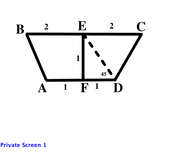ABCD is a trapezium with AD & BC as parallel sides. E is a point on BC in such a way that ABED becomes a parallelogram. The ratio of the area of ABED to that of ABCD is
a) (AD + BC)/(AD + BE)
b) (AD + BE)/(AD + BC)
c) BE/BC
d) BC/BE
e) AD/BC
OE B
Parallelogram and Area
This topic has expert replies
- GMATGuruNY
- GMAT Instructor
- Posts: 15539
- Joined: Tue May 25, 2010 12:04 pm
- Location: New York, NY
- Thanked: 13060 times
- Followed by:1906 members
- GMAT Score:790
Let ABCD and ABED look as follows:coolhabhi wrote:ABCD is a trapezium with AD & BC as parallel sides. E is a point on BC in such a way that ABED becomes a parallelogram. The ratio of the area of ABED to that of ABCD is
a) (AD + BC)/(AD + BE)
b) (AD + BE)/(AD + BC)
c) BE/BC
d) BC/BE
e) AD/BC
OE B

Area of parallelogram ABED = bh = (AD)(EF) = 2*1 = 2.
Area of trapezoid ABCD = (b� + b₂)/2 * h = (AD + BC)/2 * EF = (2+4)/2 * 1 = 3.
(ABED)/(ABCD) = 2/3. This is our target.
Now check the answer choices to see which yields our target of 2/3.
Only B works:
(AD + BE)/(AD + BC) = (2 + 2)/(4 + 2) = 4/6 = 2/3.
The correct answer is B.
Private tutor exclusively for the GMAT and GRE, with over 20 years of experience.
Followed here and elsewhere by over 1900 test-takers.
I have worked with students based in the US, Australia, Taiwan, China, Tajikistan, Kuwait, Saudi Arabia -- a long list of countries.
My students have been admitted to HBS, CBS, Tuck, Yale, Stern, Fuqua -- a long list of top programs.
As a tutor, I don't simply teach you how I would approach problems.
I unlock the best way for YOU to solve problems.
For more information, please email me (Mitch Hunt) at [email protected].
Student Review #1
Student Review #2
Student Review #3
Followed here and elsewhere by over 1900 test-takers.
I have worked with students based in the US, Australia, Taiwan, China, Tajikistan, Kuwait, Saudi Arabia -- a long list of countries.
My students have been admitted to HBS, CBS, Tuck, Yale, Stern, Fuqua -- a long list of top programs.
As a tutor, I don't simply teach you how I would approach problems.
I unlock the best way for YOU to solve problems.
For more information, please email me (Mitch Hunt) at [email protected].
Student Review #1
Student Review #2
Student Review #3
GMAT/MBA Expert
- Jay@ManhattanReview
- GMAT Instructor
- Posts: 3008
- Joined: Mon Aug 22, 2016 6:19 am
- Location: Grand Central / New York
- Thanked: 470 times
- Followed by:34 members
I suggest you draw a trapezium such that AD & BC are its parallel sides and BC is the longest side. It is given that E is a point on BC such that ABED becomes a parallelogram.coolhabhi wrote:ABCD is a trapezium with AD & BC as parallel sides. E is a point on BC in such a way that ABED becomes a parallelogram. The ratio of the area of ABED to that of ABCD is
a) (AD + BC)/(AD + BE)
b) (AD + BE)/(AD + BC)
c) BE/BC
d) BC/BE
e) AD/BC
OE B
We know that area of trapezium ABCD = (Sum of parallel sides) * Height = (AD + BC) * Height;
Area of parallelogram ABED = (Sum of parallel sides) * Height = (AD + BE) * Height;
=> Ratio of the area of ABED to that of ABCD = [(AD + BE) * Height] / [(AD + BC) * Height]
=> Ratio of the area of ABED to that of ABCD = (AD + BE) / (AD + BC)
OA: B
-Jay
_________________
Manhattan Review GMAT Prep
Locations: New York | Singapore | London | Dubai | and many more...
Schedule your free consultation with an experienced GMAT Prep Advisor! Click here.



















